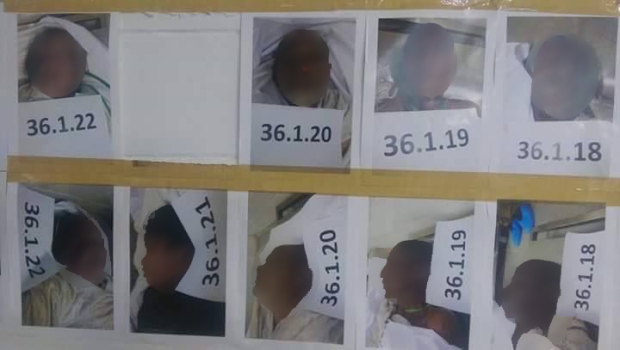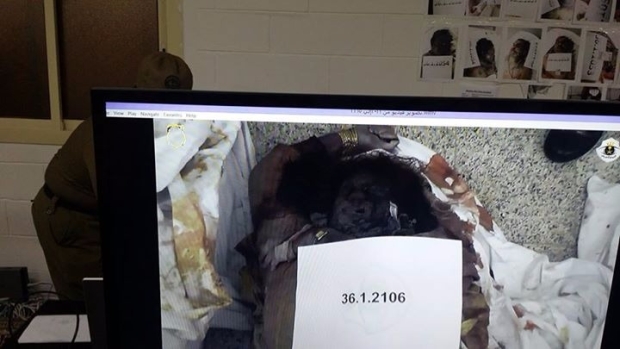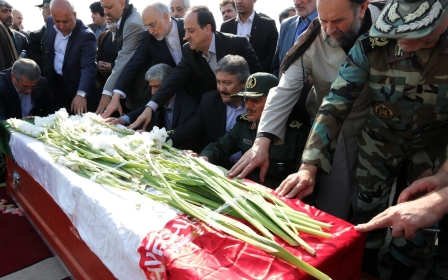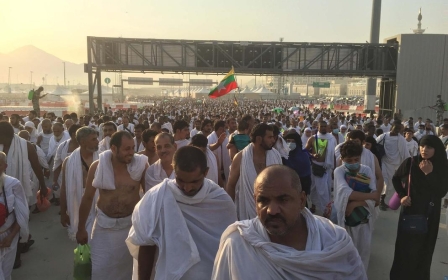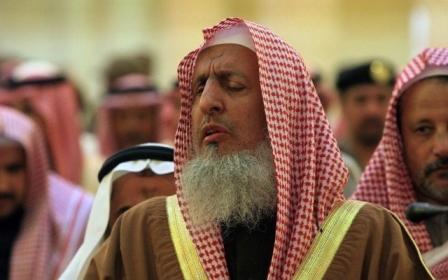Saudi Hajj disaster: Photos suggest true death toll in thousands

The number of people killed in Saudi Arabia’s Hajj disaster may be far higher than the 769 quoted by official sources, potentially making it the highest loss of life the annual pilgrimage has ever seen, Middle East Eye can reveal.
We have seen evidence suggesting that at least 2,432 people were killed on 24 September when pilgrims were crushed to death at a crossroads in Mina, inside Mecca and not far from the holy city.
Photos displayed at the Muaism Medical Emergency Centre in Mina, where people are being permitted to search for missing relatives until 30 October, appear to reveal a numbering system of those killed.
A Saudi source travelled to Mina on 30 September and spent four days visiting the centre, where he covertly took photos of what he found and sent them to Middle East Eye, requesting anonymity for fear of being arrested.
On top of each body is a sign bearing a number composed of three parts, two of which remain the same in the photographs seen by Middle East Eye.
The first refers to the year of death according to the Islamic calendar, 1436, while the second indicates a code given to the location in which the body was processed.
The third figure is the serial number given to every body processed at each location.
Photographs seen by Middle East Eye show a row of bodies laid out in the morgue, each of which has been attributed an ascending serial number.
The source sent Middle East Eye more than 50 photos of the dead, demonstrating the sequential numbers rising.
The highest numbered body seen by Middle East Eye was 2,106, nearly three times the official death toll announced by Saudi authorities.
MEE’s source claimed that he saw numbers even higher than 2,106, going up to 2,253, but said that he had been unable to take more photos due to fears of raising the suspicion of patrolling police officers.
The source also sent MEE a copy of the report from the coroner’s office in Jeddah, which they said had been obtained while they were in the Red Sea port city. That report registered 326 deaths in Jeddah hospitals as a result of the Mina crush.
This would bring the death toll to at least a potential 2,432 people, which would make it easily the worst disaster ever to hit the annual pilgrimage, surpassing a stampede in 1990 that saw 1,426 pilgrims killed.
The source said that they believed the toll to be significantly more than the potential 2,534, claiming that a large number of people had been transferred to hospitals in the city of Taif, where a list of the dead has not yet been released.
Reports of a death toll in the thousands, rather than the hundreds, chimed with a doctor who worked in the accident and emergency section of a hospital in Mina on the day of the disaster.
The doctor spoke to Middle East Eye on condition of anonymity, saying medical teams at the scene could not believe that only hundreds were killed.
“There were bodies everywhere,” the medic said, estimating that thousands of people could be dead and stressing that the crush was definitely a bigger catastrophe than the government had admitted to.
A spokesperson for the Saudi embassy in London contacted by Middle East Eye refused to comment on the allegations. However, the kingdom has defended its toll when challenged by others.
Indian and Pakistani authorities said on 28 September that Riyadh had given their diplomats 1,100 photos of people killed in Mina.
A spokesperson for the Saudi Interior Ministry released a statement in response stating that these photos included people who died of natural causes, as well as unidentified victims from an earlier disaster when a crane collapsed in Mecca on 11 September, killing 111 people.
The Associated Press, however, has also reported that by tallying up official statements they calculated that over 1,100 must have died in the pilgrimage crush.
The incident has also sparked a war of words between Saudi Arabia and its regional rival Iran, which has said that at least 464 of its citizens were killed in Mina.
Tehran has accused Riyadh of mismanaging the annual pilgrimage, which this year saw more than 2 million people take part from across the world.
Iranian state media has claimed that over 4,000 people were killed in the crush, and lawmakers have angrily called for Saudi Arabia to be stripped of organising the Hajj.
Riyadh has dismissed Tehran’s allegations, but is now facing more questions about its tallying of the Mina dead, this time from Turkey.
A Turkish official from the Body of Religious Affairs, Mohammed Gormaz, said on Wednesday that he is preparing a report to send to the Saudi authorities. The report is based on eyewitnesses, and says the number of deaths could be “in the thousands” and questions why there is still no “reasonable explanation” for why such a large number were killed.
Though Gormaz said he believes the Iranian claim of 4,000 dead could be over-exaggerated, he suggested that Saudi Arabia should share the administration of the Hajj with other Muslim countries. These comments led Turkish President Recep Tayyip Erdogan to step in, restating Turkey's support for Saudi administration of the Hajj.
Families still searching
Amid a regional war of words, large numbers of people are still searching for missing loved ones presumed injured or dead.
“Injured people were transferred to hospitals throughout the kingdom, so their relatives are not sure where to look,” local Hajj organiser Abu Jaffar told MEE by telephone from Safwa City in the Eastern Province.
He praised the authorities for providing help to those searching for missing relatives, but said the extent of the ongoing crisis is not clear.
“I don’t know how many injured people are still in the hospitals. Nobody does, apart from the government,” he said. “People go to the morgues and all the photos are displayed there. They can look through all the photos, pictures of the dead people’s faces, until they find their relatives.”
“The families must carry on looking. Once they know their relatives are dead, that’s the end of the story. But while they are still lost, they must carry on searching.”
MEE’s source who visited Mina said that some bodies are now being stored in refrigerated lorries because “all the morgues are full,” adding that he fears many families may never be able to find their relatives.
“Day by day bodies are changing colour and getting blacker,” they said. “For this reason, some of the dead have been buried by the authorities without the families being able to identify them.”
“It’s a huge disaster – this has never happened before.”
Middle East Eye propose une couverture et une analyse indépendantes et incomparables du Moyen-Orient, de l’Afrique du Nord et d’autres régions du monde. Pour en savoir plus sur la reprise de ce contenu et les frais qui s’appliquent, veuillez remplir ce formulaire [en anglais]. Pour en savoir plus sur MEE, cliquez ici [en anglais].


